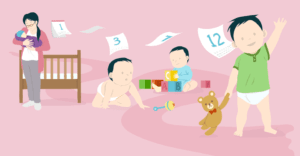
There is nothing better than watching your newborn growing and changing every day. Parents often look forward to when their child reach their developmental milestones, such as smiling, rolling over, sitting up, walking, etc. Have a look at some common developmental milestones and the ages at which your baby normally reach them, so you may know whether they are on track or not.

Most babies reach this milestone by the time that they are seven or eight weeks old. Smiling is your child’s first social skill as well as a signal of emotional growth. Your baby will smile in response to your voice or sight of your face.
By six to twelve week you will hear the sweetest sound of all that is your baby’s laughter. Tickling, peek-a-boo, silly face is all that it takes to make him laugh. It’s also an indication that colic, which is making your baby irritable is improving.
It’s one of the first major motor milestones which most babies reach by the time that they are five to six months old. It requires strength and coordination to roll from back to front and again from front to back. You must make sure that your baby has a safe place to try it out. It is highly recommended to place your baby on his or her back for sleep for SIDS prevention.
Around 5 to 6 month your baby has enough balance, arm strength, and head, neck, and lower-body control to be able to sit up initially with the support either leaning on furniture or pillows or by putting their hands in front for balance. Usually, by 8-9 months most babies can sit steadily without support.
Seeing your baby stand with support is amazing as you just know that in no time he/she will be walking and running. Most babies reach this milestone by the time they are around 7to9 months old. At around 8 months, he/she will be able to stand up on their own as their torso and leg muscles will be strong enough. Make sure to remove objects that have sharp edges or that are not sturdy enough for support.
Taking those first steps is the huge developmental milestone of the baby. Most babies begin to stand without support by 12 months and they also take a few small steps while holding onto furniture or other objects. Most babies take the first few steps within 10 to 13 months of age but it can take up to 18 months for other babies to take those first steps. It is called delayed walking if they aren’t walking by 18 months.
One of the big events in your baby’s young life is the first tooth. It usually starts from 6 months to 12 months of age but can vary from child to child. Teething can be uncomfortable, difficult and cause symptoms like Excessive drooling, Irritability, crying, Fever, diarrhea, etc.
“Mama! Dada!” There’s nothing better than hearing your baby calls your name, and it usually happens when your baby is around 8to9 months old. By this time, they can say at least one real word and tries to imitate others. It won’t take long before they can talk. Before their first words, your baby should be frequently jabbering or babbling. Not babbling by 12 months of age is seen as an early sign of autism or other developmental disorder.
Although waving “bye-bye” seems just a cute trick but it is an actual expression of language important developmental milestone which most babies can reach once they are seven to 14 months old. Your baby has now started to link sounds, gestures, and meaning. He now understands that waving is connected to the phrase “bye-bye”. These gestures also include pointing and reaching for things.
For more information, you can visit WebMD and whattoexpect.
We have a strong web presence all across the globe with patients in major countries like United States, Australia, United Arab Emirates, Canada, United Kingdom, most European countries, & even smaller counties like Uganda, Nepal, Bangladesh and many more.
We have a very efficient team of doctors which includes the right combination of highly experienced doctors and the doctors of the new age.
Our main aim is to make the patient comfortable so that the case can be taken with ease and the patient be treated properly.
** The text on this website is sourced from websites like emedicine and/or other verified material by government agencies around the globe along with valuable inputs and additions by our team. The content of this page is proofread and updated by the team of doctors, every once in a while, to provide the most accurate information.